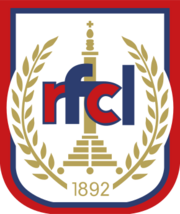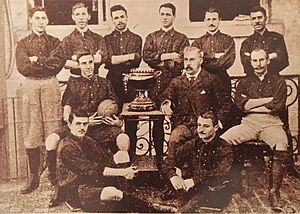RFC Liège facts for kids
 |
|||
| Full name | Royal Football Club de Liège | ||
|---|---|---|---|
| Nickname(s) | Les Sang et Marine (The Blood and Marine) |
||
| Founded | 1892 | ||
| Ground | Stade de Rocourt, Liège |
||
| Capacity | 3,500 | ||
| Chairman | Jean-Paul Lacomble | ||
| Manager | Gaëtan Englebert | ||
| League | Challenger Pro League | ||
| 2024–25 | Challenger Pro League, 9th of 16 | ||
|
|
|||
Royal Football Club de Liège, often called RFC Liège, is a professional football club from Liège, a city in Belgium. The team currently plays in the Challenger Pro League, which is the second-highest football league in Belgium.
This club has a special number, matricule 4. This means it was the fourth club ever to register with the Royal Belgian Football Association, which started in 1895. RFC Liège was also the very first Belgian champion in history! They have won 5 national championships and 1 Belgian Cup. The club focuses on developing young local players and has very loyal fans. For a long time, between 1995 and 2015, the club didn't have its own home stadium. But now, they play on their own field in the Rocourt area of Liège.
In 1990, RFC Liège was involved in a very important legal case for European football. Their decision not to let player Jean-Marc Bosman leave after his contract ended led to the Bosman ruling. This big decision by the European Court of Justice changed how football transfers work across Europe.
Contents
Club History
How RFC Liège Started
Football came to the city of Liège in the late 1800s, brought by English workers. The Parc de la Boverie, which had a cycling track, quickly became a popular spot for the first football players. Cyclists were among the first to get interested in this new sport. It was a great way for them to stay fit during the winter months.
On February 14, 1892, the Liège Football Club was officially founded. It was started by members of the Liège Cyclist's Union. On the same day, they also organized the first "Liège-Bastogne-Liège" cycling race, which is the oldest one still running today. The club's first official football match was in Brussels, where they lost 4–0.
Later, the club grew quickly. They got their revenge against the Brussels team on a new field. This field was in the gardens of the Château de Sclessin. For this match, the team wore red and blue jerseys. These colors were a tribute to an English club from London called Dulwich Hamlet F.C..
Becoming Belgian Champions
In 1895, Liège FC became one of the first clubs to join the Belgian Football Association. They changed their name to Football Club Liégeois (FC Liégeois). The club then won the very first national championship of Belgium in the 1895–96 season. This made them the first-ever Belgian Champions!
Most players in that first winning team were Belgian, like Fernand Defalle and Lucien Londot. But they also had English players, such as Samuel Hickson, who was the top scorer that season. Some players from this team, like Londot, even played for the Belgium national football team.
FC Liégeois won two more titles in a row, in 1898 and 1899. In 1899, they beat FC Brugeois 6–3 in the final. During this time, the team had an amazing unbeaten streak of 23 official matches. This lasted for over two years, from February 1897 to November 1899. Eventually, teams from Brussels became stronger, and FC Liégeois faced some tough years. They even became the first former Belgian champions to be moved down to the second division.
In 1920, the club added "Royal" to its name, becoming Royal Football Club Liégeois. By the time they won championships again in 1952 and 1953, their name was shortened to RFC Liège. They were one of the few clubs that could challenge the strong team R.S.C. Anderlecht during that period. In the 1963–64 Inter-Cities Fairs Cup, RFC Liégeois reached the semi-finals but lost to Real Zaragoza from Spain. From 1965 to 1985, the club had some difficult results. They managed to survive by relying on their young players and loyal fans.
In the late 1980s, RFC Liège played in European competitions. They faced famous clubs like Benfica and Juventus. The club also won a Belgian Cup in 1990.
The Bosman Ruling
In 1990, a player named Jean-Marc Bosman wanted to leave RFC Liège after his contract ended. The club wanted a transfer fee from the French club Dunkerque, even though Bosman's contract was finished. Dunkerque refused to pay. This led to a series of court cases that resulted in the famous Bosman ruling in 1995. This ruling changed football rules, allowing players to move freely to other clubs once their contracts expire, without a transfer fee.
Recent Club History
In 1995, the club faced big problems. Their stadium, Stade Vélodrome de Rocourt, was sold and torn down to build a movie theater. To keep going, the club joined with another team, R.F.C. Tilleur-Saint-Nicolas. They became R. Tilleur F.C. de Liège.
The club moved down from the First Division, where they had been since 1945, to the Third Division. In 2000, the "Tilleur" part was dropped from the name, and they became "RFC Liège" again. From 1995 to 2009, the club moved between the Second and Third Divisions. They won the Third Division title twice, in 1996 and 2008.
In the 2008–09 season, the club played in the Second Division. However, they were moved down two times in a row, ending up in the Fourth Division by April 2011. During the 2010–11 season, RFC Liège played its 3000th national match and scored its 5000th goal at the national level.
In the 2015–16 season, RFC Liège played in Division 3. RFC Liège holds the Belgian record for the most seasons played at a national level, with 117 seasons between 1896 and 2019. This includes 67 seasons in the First Division, with 50 of those being in a row (1950–1995). They have also played 28 seasons in the Second Division, 11 in the Third, and 2 in the Fourth.
RFC Liège is still the only club that has played all its national seasons (117 as of 2019–20) at a national level, not just local games. They have won five First Division championships: 1896, 1898, 1899, 1952, and 1953. This makes them the 6th most successful active Belgian club.
In the 2022–23 season, RFC Liège earned promotion to the Challenger Pro League for the 2023–24 season. They secured this after a 0–0 draw at Tienen in Matchweek 35. On May 14, 2023, the club finished as runner-up in the Belgian National Division 1 for the 2022–23 season.
Home Stadium
From 1921, RFC Liège played at the Stade Vélodrome de Rocourt. This stadium was in the area of Rocourt, which became part of the city of Liège in 1977. In 1995, the stadium was sold and torn down. This is why RFC Liège was called 'homeless' for a while.
Between 1995 and 2015, RFC Liège played their home matches in different places. They played in Tilleur (1995–2000), Seraing (2000–2004), Ans (2004–2008), and then back in Seraing (at Pairay Stadium, 2008–2015).
Finally, in 2015, the club returned to Rocourt. They now play their home games in the new Stade de Rocourt.
Team Players
|
|
Club Staff
Club Achievements
League Titles
- Belgian First Division
- Champions (5): 1895–96, 1897–98, 1898–99, 1951–52, 1952–53
- Runners-up: 1896–97, 1958–59, 1960–61
- Belgian Second Division
- Winners: 1911–12, 1922–23, 1943–44
- Belgian Third Division
- Winners: 1942–43, 1995–96, 2006–07
- Belgian Fourth Division
- Winners: 2014–15
- Belgian National Division 1
- Runner-up: 2022–23
Cup Wins
- Belgian Cup
- Winners: 1989–90
- Runners-up: 1986–87
- Belgian League Cup
- Winners: 1986
- Runners-up: 1973
See also
 In Spanish: RFC Lieja para niños
In Spanish: RFC Lieja para niños


